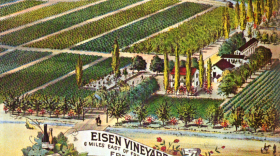They were one of the most unusual elements of the Central Valley's natural landscape, and for decades their origins puzzled scientists. Today on KVPR’s Central Valley Roots – the story of valley’s so-called “hog wallows.”
Imagine the valley before today’s farms and cities. Miles of grassland on the flat valley floor. Yet in some places you’d find something really odd – hundreds of mounds of earth, some as much as four feet tall, scattered on the landscape. In between the mounds were depressions that turned to vernal pools during the rainy season.
The Yokuts believed the mounds were leftover soil from the birds and animals that built the Sierra. In the 1870’s, white settlers labeled them “hog wallows.” Scientists offered a variety of explanations. Some suggested they were the remnants of ancient glaciers, others thought they were the result of erosion, or even seismic activity. About the only thing they agreed on was the mounds weren’t created by hogs.

While hog wallows are increasingly rare today, there is one place you can still find them – the hog wallow preserve near Lindcove in Tulare County. Surrounded by citrus trees on all sides, this 10 acre parcel is one of the few on the valley floor that remains undistributed. It’s a rare window into the valley’s past. And as for their origin – the latest research suggests the mounds are actually the work of pocket gophers. For KVPR’s Central Valley Roots, I’m Joe Moore.





